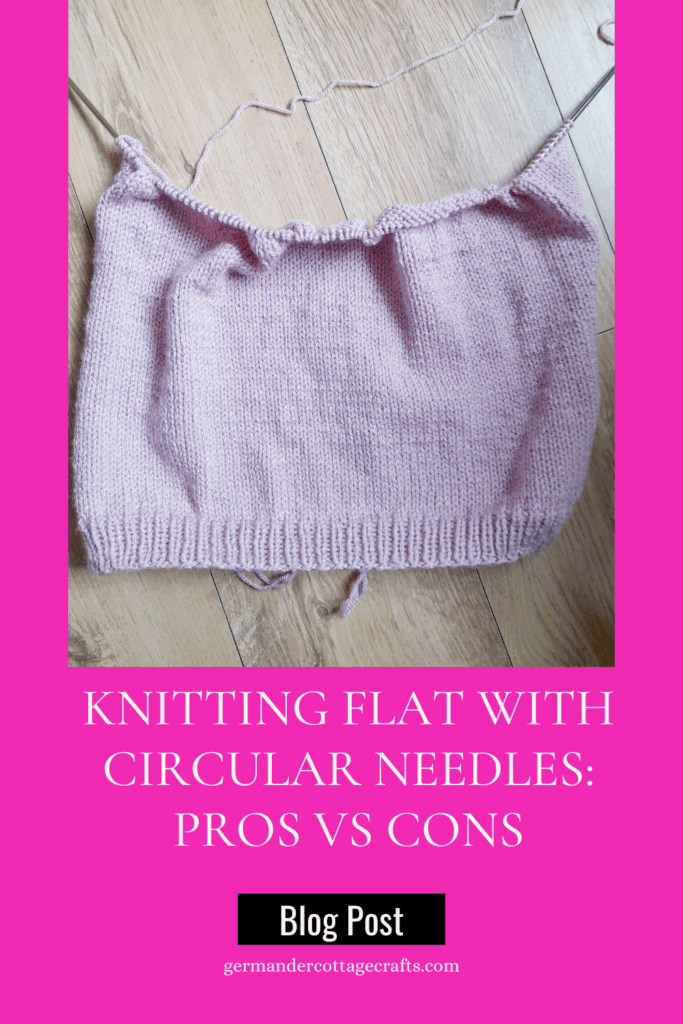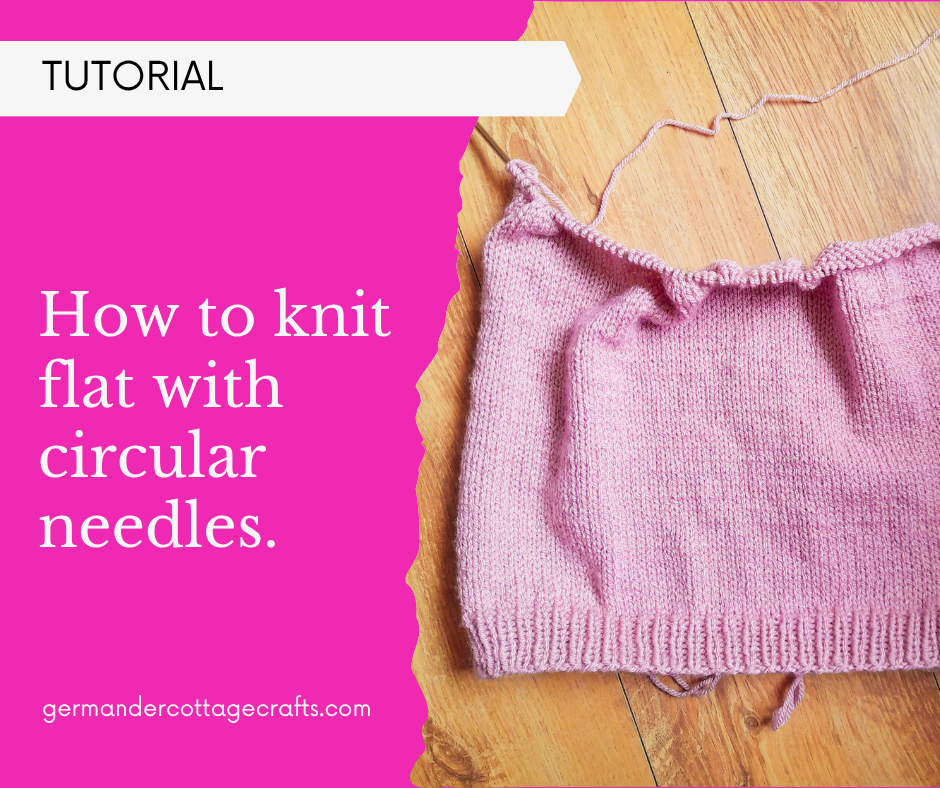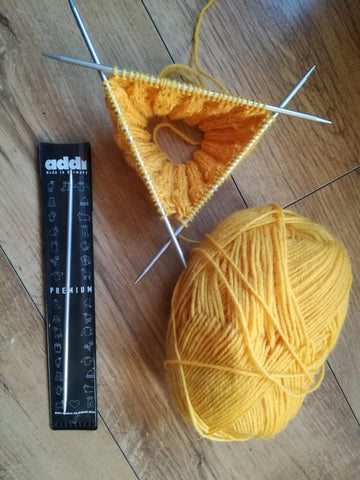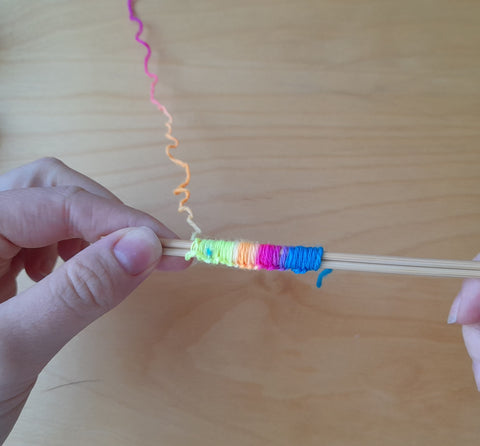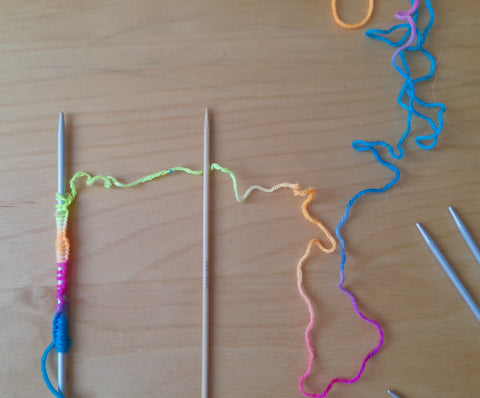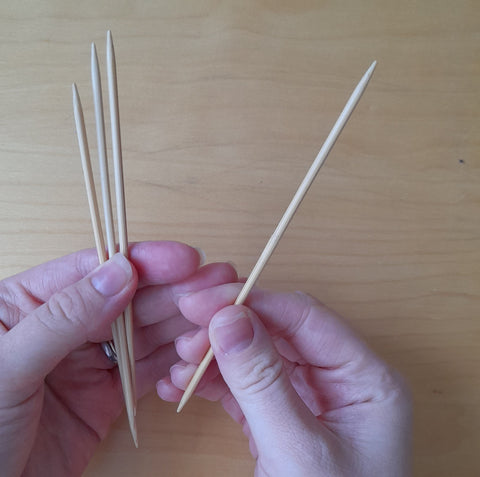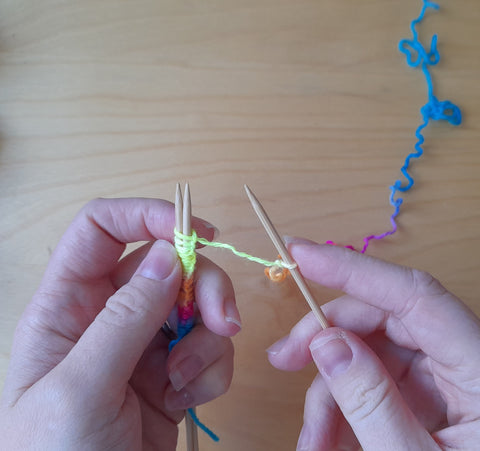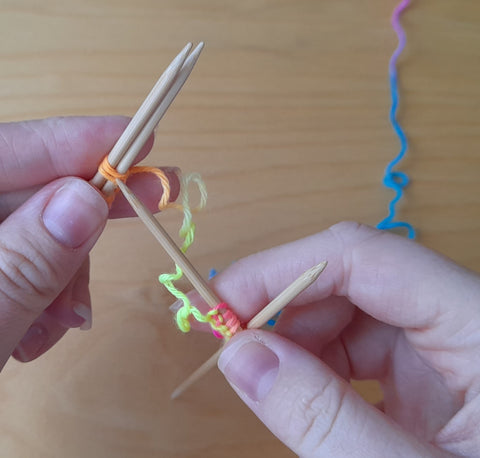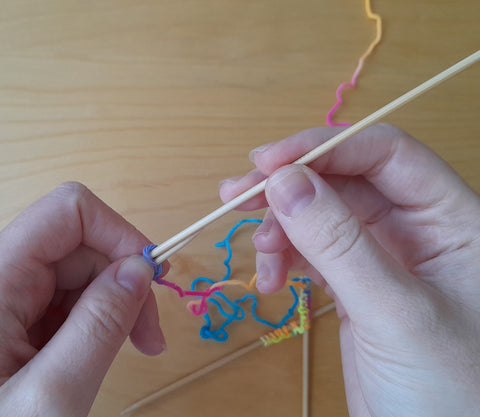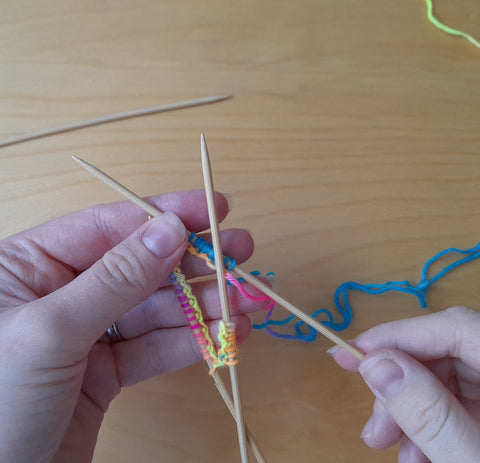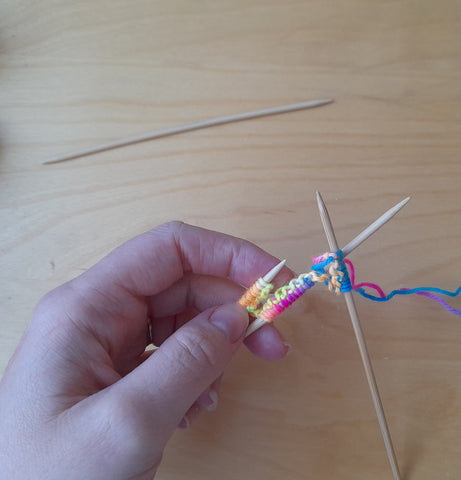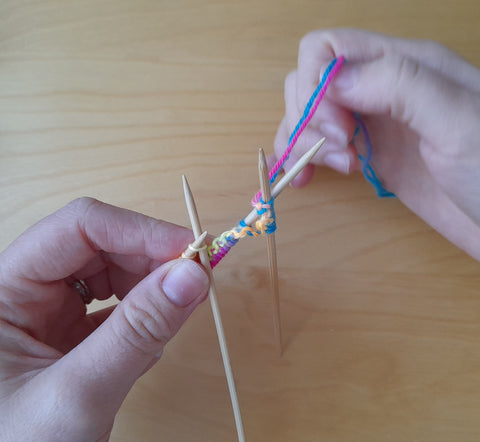Can you knit flat with circular needles? Yes! You absolutely can.
I’ve seen this question come up several times in knitting groups. Even advanced knitters will ask, ‘can you knit flat on circular needles?’ and the answer is yes. In this blog post I’ll talk you through the pros and cons of circular needles, and how you can use them to knit anything! I will also guide you through the essential kit you need for knitting with circular needles.

This article contains some affiliate links. This means that if you choose to purchase via the links provided, I earn a small commission at no extra cost to you.
You can knit flat with circular needles, and here are a list of benefits you get from doing that:
- Eases the weight on your wrists and arms.
Unless you’re an armpit knitter, you’ll probably start feeling the weight of your flat needles after a couple of hours of knitting. You can always take a break, but if you want to get back into it, using circulars can help take the pressure off. As your piece gets bigger, it can start putting pressure on your hands and wrists. Sliding the stitches onto circulars is a more efficient, lighter way to knit larger pieces.
- You can knit larger things
If you have a long cord on your circular needles, you can knit anything! Knit men’s XXL sweaters; knit baby blankets right up to king size throws with circular needles. Little coats and cardigans also benefit from being knit on circulars, as you can hold the entire thing on the cord while you attach the sleeves or knit the collar. Look out for cardigans and coats that are ‘top down’ or ‘bottom up’ in their construction, and have fun knitting the whole thing on one cord without the need of several stitch holders.
- Use the circular needles as stitch holders.
If you need a rest from the project you’re working on, you might find leaving it on circular needles more handy than finding a huge stitch holder. If you are using circular needles that have removable cords, it’s even easier! Unclip or unscrew the needles you’re using and knit something else with them. Your project will be safe on the cord.
- Make your project more portable.
Knitting with straight needles is fine when you’re on a sofa at home, but if you’re trying to knit on public transport or on a park bench, you might benefit from knitting flat with circular needles. If you’re an English knitter like me, you’ll find that your arm action can cause your needles to catch everything around you! There’s nothing more tragic than seeing your stitches slide off the end because you got caught in a curtain and dropped the needle. I can’t guarantee that this won’t happen with circular needles, but it presents a much slimmer possibility of slip-offs.
Common misconceptions about knitting flat with circular needles.
“You can’t use circulars because you have to keep flipping your work.” No, no you don’t. You finish your row and start working back on the other needle, just like with straight knitting pins. There is no flipping involved unless you’re knitting a pancake.
“Circular needles aren’t suitable for beginner knitters.” Again, this is nonsense. It’s like with exercise: do something you enjoy and you’ll do it often. The same goes for knitting. If you learn to knit on circular needles, that’s fine. It’s perfectly doable. Circular needle tips come in every size out there, so I don’t see why a beginner couldn’t do it. Some knitters with mobility issues might actually find starting with some light aluminium circulars quite comfortable! The weight is taken out of it, and the cord can rest on your lap or on a cushion.
“Circular needles are only good for knitting in the round.” No, they’re handy for every project. Every project!
Drawbacks of knitting flat with circulars
There are only some, but you should still watch out for them:
- They’re incredibly light so you could have trouble casting on.
Keep hold of them and keep an eye on them. Perhaps lay the needles on your lap or on a hard surface to make sure they don’t fall onto the floor. The casting on is the trickiest part, I find, as they’re not hard and heavy like straight needles.
- Sliding on to the cable.
Stitches will slide on to the cable and this is where you need to manage your tension. If you’re casting on too tightly, those stitches won’t slide back up the needle so that you can knit with them! try and keep the stitches even and wide enough to fit onto the needles.
- Dropping stitches.
As I said before, no one can guarantee that you won’t drop stitches.
Dropping stitches is sometimes really hard to avoid. I actually tend to drop a lot of stitches on straight needles as I seem to knock into them a lot or get them caught in my sleeve.
With circulars, you could drop the stitches simply because the circular cord has been weighed down too much by your work. This will then pull the needle downwards and out of the stitches! Keep an eye on it and work with your lap or a hard surface when you are starting out.
You will also drop stitches if you’re using a really smooth material to knit with. Aluminium can be very sleek, so just remember to be careful when you put you knitting down. You can also use needle stoppers or a connector, like the one that comes with addi click needles.

What to consider when choosing circular needles:
What is the project? This is an important question to ask as if it is socks, you’ll want needles that are lightweight and easy to port around.
What material do you like to use?
Bamboo and driftwood are popular for their lightness and warmth, but they’re prone to snapping if you’re not careful! For something small like a sock, you may want to try a metal needle as they can go really thin without risking breakage.
How pointy do they need to be?
If you’re knitting lace, you will want a sharper, more accurate tip on your needles.
What length do they need to be?
If you’re using magic loop for a hat, socks or gloves, you need to consider how long your cord is. Likewise, you need to consider how long the cord is if you’re wanting to simply fit the whole thing on it! Circular needles come in a range of cord lengths from around 40cm to over 150cm. The sky really is the limit.
Shop the range at Lovecrafts.
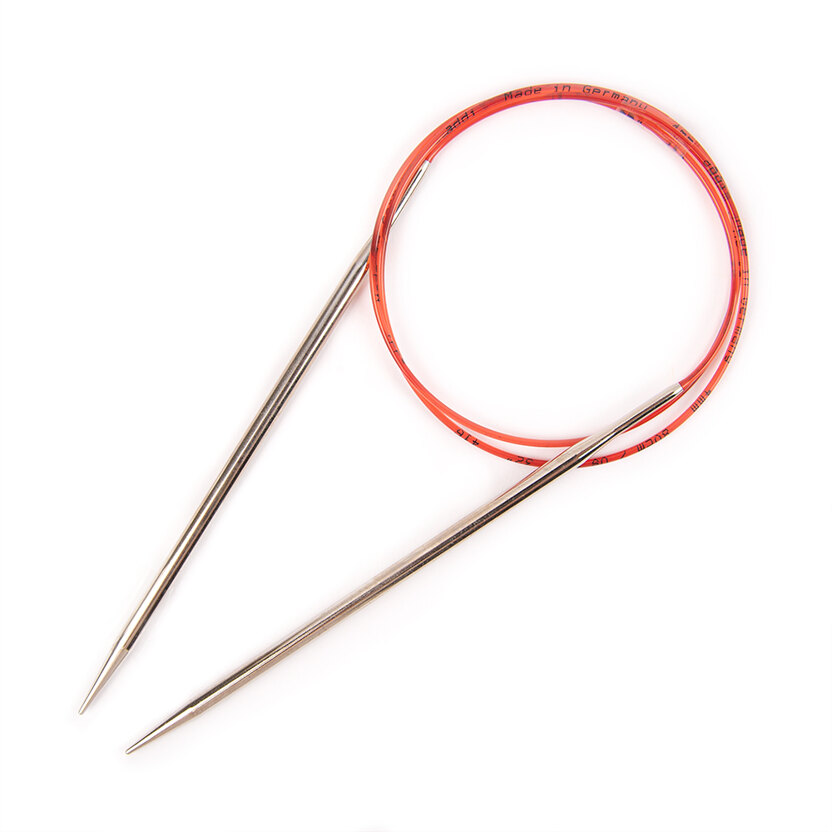
My personal circular knitting needle favourites:
Addi Click Basic Interchangeable Set

I have always loved my addi click set. They’re just basic aluminium needle tips with a plastic cord, and they click into place! You just click and go. I think as with all interchangeable needles, they come with a risk of disconnecting mid-project. In the 12 years I’ve had these, I think they’ve only come off once, and I’m not even 100% sure that it wasn’t my fault!
Addi are a perfect introductory brand for knitters. I also use Addi lace and Addi turbo for my projects. I started out with an Addi Click set, and these days you can get them in all the material types. There is a set for every budget. My cords are a little bit kinked these days (they’re over 10 years old!) but if you can’t straighten them with hot water, you can find replacement cords easily in any of the main knitting supplies stores. What knitter won’t need a few extra cords?

Chiaogoo interchangeble needles. These were a birthday present a few years ago, and I love them. They’re sharp, strong steel and although they can sometimes unscrew themselves mid-project, this rarely happens! You get a little pin that helps you secure them nice and tight. The cords don’t kink as easily as my addi needles or knitpro needles. They have a coil inside that keeps them straight. Really handy to have. You also get a nice little ruler for gauge, as well as stitch markers, life saving cord stoppers and T pins.

Knitpro Zing circular needles: These are so, so handy. Out of the needle types that I have, I think the Knitpro cords are the trickiest to keep straight. They can kink and knot in my knitting bag. Also, because the metal needles have a colour coating on them, they don’t help the stitches glide as easily. They have a good sharpness to the tips, so that’s great if you’re using them for a range of projects.
They come in a different colour for each size, so you really can collect them all. You can also get them in an interchangeable set:

